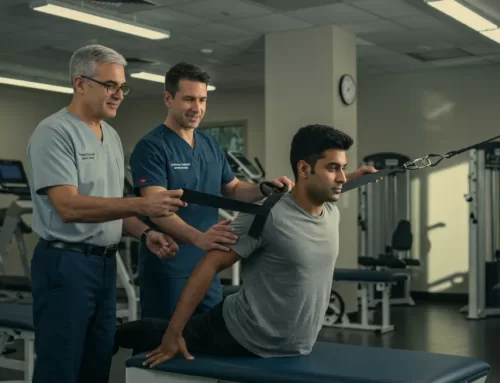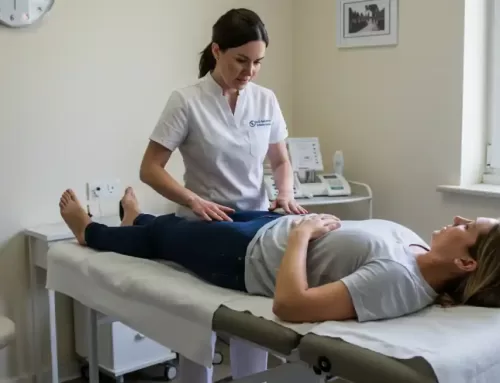Pediatric physiotherapy is a specialized branch of physiotherapy that focuses on treating children with a wide range of physical conditions. From developmental delays to injuries and congenital disorders, pediatric physiotherapists work to enhance children’s physical abilities, improve movement, and ensure optimal development. By addressing issues early on, these therapists play a crucial role in preventing long-term physical problems, enhancing mobility, and improving quality of life. In this article from Physio Cottage, we will explore the most common conditions treated in pediatric physiotherapy, how these therapies benefit children, and why early intervention is key to achieving the best results.
What is Pediatric Physiotherapy?
Pediatric physiotherapy is the assessment, diagnosis, and treatment of physical conditions in children ranging from newborns to teenagers. The goal of physiotherapy is to support children in achieving their physical milestones, managing injuries or illnesses, and improving mobility for everyday activities. Pediatric physiotherapists use a variety of techniques, including exercises, manual therapy, and specialized equipment, to help children achieve their full physical potential.
Since children’s bodies are still developing, physiotherapy treatments are adapted to their age, growth, and developmental needs. Early intervention, which often begins in infancy or toddlerhood, plays a significant role in helping children overcome movement difficulties and preventing further complications as they grow.
Need Physiotherapy Services in Scarborough? Call us
Common Conditions Treated in Pediatric Physiotherapy
Pediatric physiotherapy helps with many conditions, ranging from simple posture problems to complex neurological conditions. Below are some of the most common conditions treated by pediatric physiotherapists:
Developmental Delays
Developmental delays refer to a child’s delayed achievement of physical milestones, such as crawling, walking, or running. These delays may be due to genetic conditions, premature birth, or environmental factors. Children with developmental delays may struggle with balance, coordination, and motor skills, which can impact their overall ability to engage in physical activities. Pediatric physiotherapists design specific exercises to promote movement, enhance strength, and improve coordination. Working with children on a developmental timetable helps them catch up to their peers, with therapies that may include games, stretches, and play-based activities.
Common treatments include balance exercises and activities to promote motor skills, strength-building exercises focusing on muscles needed for movement, and coordination training using fun, interactive games.
Cerebral Palsy (CP)
Cerebral palsy is a neurological disorder caused by brain injury or abnormal brain development, affecting movement, posture, and muscle coordination. Children with CP may experience muscle spasticity (tightness), weakness, or involuntary movements that limit their ability to sit, stand, or walk. Pediatric physiotherapists work to improve muscle strength, flexibility, and motor coordination. Therapy may involve stretching exercises, strengthening activities, posture correction, and gait training. Some children with CP may also benefit from specialized equipment like braces or wheelchairs to improve mobility.
Common treatments include stretching and strengthening exercises to reduce muscle tightness, gait training, including walking and balance exercises, and the use of assistive devices such as orthotics and braces.
Musculoskeletal Injuries
Children are often active and engaged in sports or physical play, which increases the risk of injuries such as sprains, fractures, strains, or tendon injuries. Musculoskeletal injuries can affect a child’s ability to move comfortably or engage in physical activities. Physiotherapists help with the rehabilitation of musculoskeletal injuries by creating individualized treatment plans that promote healing and restore strength. This might involve a mix of strengthening exercises, mobility training, and techniques such as manual therapy, taping, and cold or heat therapy.
Common treatments include range-of-motion exercises to regain flexibility and mobility, strengthening exercises to rebuild muscle and support joint function, and manual therapy (massage or joint manipulation) for pain relief and improved movement.
Torticollis (Wry Neck)
Torticollis is a condition where the muscles on one side of the neck tighten, causing the head to tilt in an abnormal way. This condition may be congenital (present at birth) or acquired later in life due to muscle strain or injury. Pediatric physiotherapists can treat torticollis through stretching exercises and gentle manipulation of the neck muscles to reduce tightness and improve movement. Early intervention is important to prevent the condition from causing long-term postural issues or affecting a child’s ability to turn their head.
Common treatments include neck stretches and gentle massage to improve flexibility, strengthening exercises for the neck and upper back, and posture education and positioning strategies.
Flat Feet (Pes Planus)
Flat feet, or pes planus, is a common condition where the arches of the feet do not form properly, resulting in a “flat” foot appearance. This can cause pain, especially with physical activity, and can sometimes lead to postural problems or discomfort in the knees, hips, or lower back. Pediatric physiotherapists can assess the child’s walking and posture to determine the best course of action. Treatments may include exercises to strengthen the foot and lower leg muscles, orthotic supports to improve arch function, and gait retraining to correct walking patterns.
Common treatments include foot and ankle strengthening exercises to improve foot function, use of custom orthotics or arch supports, and education on proper walking mechanics.
Spinal Curvature Disorders: Scoliosis, Kyphosis, and Lordosis
Spinal curvature conditions, including scoliosis (sideways curvature), kyphosis (excessive forward curvature), and lordosis (excessive inward curvature), can affect a child’s posture, breathing, and overall mobility. These conditions may cause pain, stiffness, and difficulty in performing daily activities. Pediatric physiotherapists play an essential role in managing these conditions by promoting proper posture, improving spinal alignment, and preventing further progression. Treatment may involve exercises aimed at strengthening the core muscles, stretching tight muscles, and improving posture.
Common treatments include posture correction exercises to reduce spinal deformities, core strengthening and flexibility exercises, and manual therapy to alleviate pain and promote movement.
Neurological Conditions
Children with neurological conditions like muscular dystrophy, spina bifida, or brain injuries often struggle with movement, balance, and coordination. Pediatric physiotherapists work to improve motor skills, strength, and independence through a range of exercises and activities designed to stimulate the nervous system. Therapies may include movement exercises, balance training, and even adaptive devices such as walkers or braces. The goal is to maximize the child’s abilities, ensuring they can move as independently and comfortably as possible.
Common treatments include strengthening exercises to promote muscle function, balance and coordination training to improve movement control, and adaptations like braces or assistive devices to aid mobility.
Gait Abnormalities
Gait abnormalities refer to irregular walking patterns, such as limping, toe-walking, or abnormal limb movement. These can be caused by a variety of issues, including muscle weakness, joint misalignment, or neurological conditions. Pediatric physiotherapists assess the child’s walking pattern and design treatment plans that target the root causes of the abnormal gait. Treatment may involve exercises to strengthen muscles, improve balance, and promote correct walking techniques.
Common treatments include gait training to improve walking patterns and coordination, strengthening exercises for muscles involved in walking, and use of orthotics or braces to support walking mechanics.
Post-Surgical Rehabilitation
After surgery, whether from a fracture, congenital issue, or injury, children may need physiotherapy to regain strength, flexibility, and function. Pediatric physiotherapists assist in rehabilitation by designing safe and effective post-surgical recovery plans. Therapy typically focuses on gradually increasing mobility, improving strength, and preventing complications like joint stiffness or muscle atrophy.
Common treatments include stretching and strengthening exercises to restore function, range-of-motion activities to prevent stiffness, and gradual return to activity, including sport-specific rehabilitation.
Autism Spectrum Disorder (ASD)
Children with Autism Spectrum Disorder (ASD) often experience challenges with coordination, motor planning, and sensory processing. Physiotherapists work with children with ASD to enhance their motor skills, coordination, and sensory integration through structured and individualized exercises. Therapies may include balance and coordination activities, sensory integration exercises, and motor planning tasks designed to help children feel more comfortable in their bodies and engage with their environment.
Common treatments include sensory integration exercises to improve body awareness, coordination and balance training to enhance motor skills, and strengthening exercises to improve overall function and stability.
✔️ Also read: How Does Physiotherapy Help Improve Sleep Quality?
Benefits of Pediatric Physiotherapy
Pediatric physiotherapy offers a range of benefits that are not only crucial for treating specific conditions but also for enhancing a child’s overall health and well-being. Physiotherapy helps children reach physical milestones and develop strength, coordination, and flexibility. Through targeted exercises and manual therapy, physiotherapists can reduce or eliminate pain caused by injuries or conditions like cerebral palsy or scoliosis. Physiotherapy helps children regain movement and independence, enabling them to participate more fully in daily activities.
Early intervention can help prevent complications, such as muscle weakness, joint deformities, or developmental delays, as children grow. With improved mobility, strength, and physical function, children can lead more active, confident lives.
Sum up
Pediatric physiotherapy plays an essential role in helping children achieve their physical potential, recover from injuries, and overcome developmental challenges. With a focus on early intervention, physiotherapists can help children grow stronger, healthier, and more independent. If you notice any physical or developmental concerns with your child, it’s important to consult a pediatric physiotherapist early. The earlier treatment begins, the better the chances of improving your child’s mobility, function, and overall well-being. With the right support and therapy, children can reach their fullest potential and enjoy an active, pain-free life.




